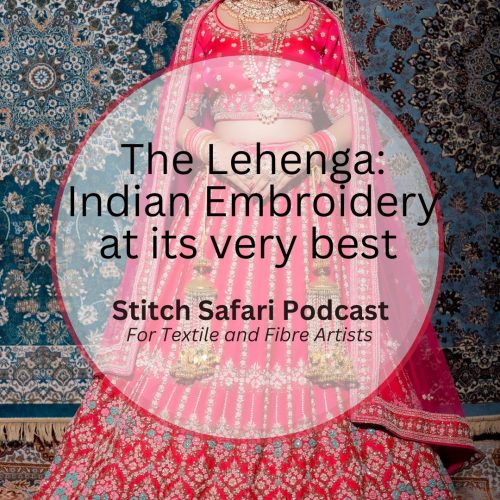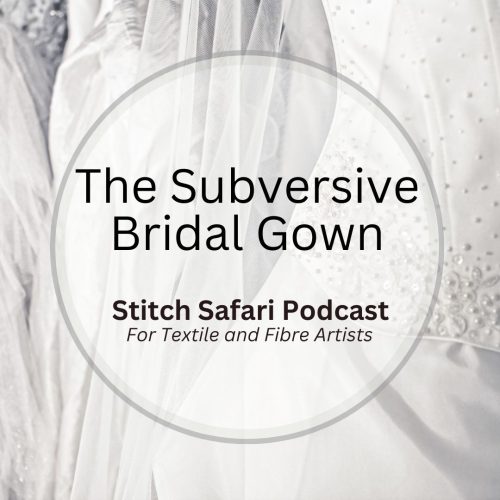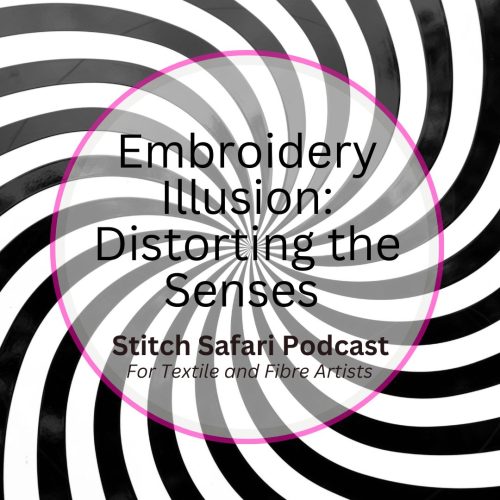The hard outer casings of the Jewel beetle, naturally mimic gem-like precious treasures in terms of utter brilliance and beauty, through their hardy, metallic, emerald iridescence – used for centuries as decoration or embellishment.
But in many cultures, they were also considered highly symbolic, playing a magical protective role against evil spirits as well as denoting kinship or social standing.
Why? Because the elytra encapsulated life-force and vitality conveyed by their spectacular non-fading colour.
Jane Nicholas in her book ‘The Stumpwork, Goldwork, and Surface Embroidery Collection, Published by Sally Milner Publishing in 2004, describes these magnificent elytra as ‘the emeralds of the insect world’. The coloured casings range from greens to blues, to purples and even pinks.
And it’s pleasing to note, with such ancient associations, that beetle-wing embroidery continues to fascinate, due to not only its colour but its durability and ability to be carefully cut and pierced – perfect for embellishment for embroidery.
In fact, in older embroideries, the ageing cloth surrounding the beetle wing embroidery has decomposed, yet the beetle elytra retain their iridescent sheen and sparkle.
Used by the Mogul elite, they were also used in other Asian cultures such as Thailand, Myanmar, China, Japan, and among Amazonian tribes and people from the Papuan New Guinea highlands in paintings, jewellery, headdresses, ornaments and textiles.
Young women from Thailand and Burma made ‘singing shawls’ for funeral ceremonies, made of woven blankets embellished with white beads and a fringe of beetle wings and bells that tinkled as they walked – helping to send the deceased safely to the afterworld.
As a commodity, beetle wings were harvested in the millions in the hardwood forests of Burma and northern Thailand, then exported to Calcutta for distribution.
So are the beetle wings ethically harvested? The beetles used for beetle wing embroidery have a very short lifespan of 3-4 weeks in their adult stage, so to avoid killing the beetles, only those that die naturally are collected.
Considered exotic and fanciful in England this form of embroidery became highly popular from the 1820s, worn by the privileged for court gowns, although Englishwomen in India had been donning beetle wing embroidered gowns from at least the 1780’s – the Indian’s much longer.
Their popularity continued up till the 1920s when the evening dresses simply couldn’t bear the weight of the heavy metal thread embroidery that often accompanied beetle wing embroidery.
They were, however, picked up by costume designers for balls, stage and theatrical work.
American actress Adora Andrews, 1872-1956, wore a gown for stage work reported to have 5,000 elytra sewn onto it, causing a newspaper sensation across the US and Canada.
Costumer Alice Comyns-Carr designed a Lady Macbeth costume for Dame Ellen Terry in 1888 incorporating beetle wings, perhaps inspiring designer Colleen Atwood to also use beetle wings in her costume for the movie Snow White and the Huntsman in 2012 worn by Charlize Theron for her character, Queen Ravenna.
In 2007 Alexandra Byrne used beetle elytra on a historically-inspired green damask gown for the movie, Elizabeth: The Golden Age, worn by Cate Blanchett.
In 2013 the design team of Aura Tout Vu presented theatrical elytra studded garments down the runway.
Not to be outdone, Belgian designer, Dries van Noten took this a step further creating faux elytra (another Victorian tradition) for his Fall/Winter 2015-16 collection.
One of the most famous beetle wing gowns ever made, was that designed by Jean-Phillippe Worth in 1902, for Lady Curzon to wear to the Delhi Coronation ball. It was meant to be a compliment to the Indian people, yet hold its own beside the sumptuous clothes and jewels worn by the Indian princes.
The magnificent gown, embroidered all over in a pattern of peacock feathers in gold thread, with a beetle wing forming the eye of each feather has now become highly controversial – if it wasn’t already.
The use of the Peacock motif was deemed inappropriate – the famous golden Peacock Throne was made for Shah Jahan in the early 17th century and the motif is of importance in the Hindu religion, with the style of embroidery traditionally only worn by Mogul rulers and the wealthy elite.
Even of its time, the use of the peacock motif was considered subtly political and seen as a statement of dominance, with the dress itself seen to be a representation of the exploitation of India’s resources and artisans.
The dress is preserved in a climate-controlled display case at Kedleston Hall, the seat of the Curzon family in Derbyshire.
The Peacock Dress also caused a sensation recently when costume designer Cathy Hay wanted to recreate the gown, documenting her work on her blog and YouTube channel.
The CosTuber community were outraged, resulting in Cathy posting further videos talking about the decimation of the Indian cotton industry by the British. She has one video diary asking the question ‘what does the Peacock Dress mean?
If you have the time, this offers a fascinating insight into modern-day perceptions.
There’s something about following in the footsteps of history when it comes to embroidery that’s utterly stimulating and uplifting.
It simply means looking back to move forward.
Image Credit: By Xufanc – Own work, CC BY-SA 3.0, https://commons.wikimedia.org/w/index.php?curid=7313204





